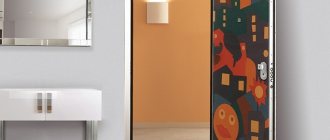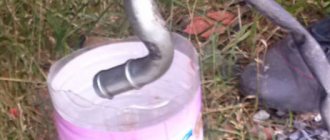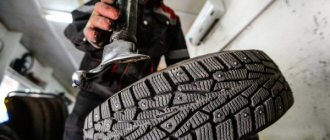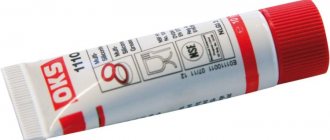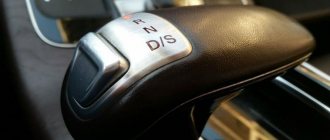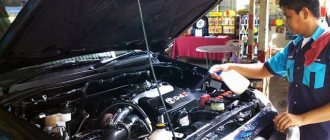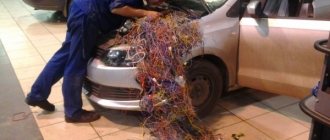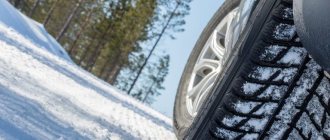Brake fluid is one of the most important working fluids used in a car. The efficiency and reliability of brake operation directly depends on its quality.
In the service book of any car there is an entry regulating the period for replacing the brake fluid. Usually this is once every two years. Manufacturers do not pull this figure out of thin air - it is the result of many years of testing, experiments and calculations.
Meanwhile, many drivers do not pay attention to such recommendations. Someone is trying to save money on this, remembering the old “Zhiguli-Moskvichev” times, when fluid was in short supply and no one even thought about such wasteful consumption, and someone even gave up on it - it doesn’t leak, it slows down and okay . Or maybe there is no need to change this fluid? Maybe this is just a trick by servicemen to get extra money from car owners? Or are there still some pitfalls, and neglect of brake fluid can lead to disaster?
Brake fluid.
Why change it?
Brake fluid works under very difficult conditions. In the urban cycle it heats up to +150°C, and when driving on a mountain road, traveling with a trailer, as well as during sports driving, it can heat up to +180°C.
Of course, modern brake fluids can withstand this kind of load: their boiling points range from +200...+260°C, depending on the brand. But brake fluid is hygroscopic, meaning it absorbs moisture. Accordingly, as the proportion of moisture in the brake fluid increases, the boiling point decreases. If brake fluid absorbs 2-3% of water over a year, its boiling point will decrease by 30-50°C, that is, boiling will occur at 145-160°C.
When the brake fluid boils, air bubbles form, and when you press the brake pedal, some of the fluid flows into the reserve tank, and the rest cannot create enough pressure, as a result, the brake pedal “falls through.”
In addition, any brake fluid consists of various additives, which over time begin to decompose, and the fluid begins to lose its other properties. For example, using old fluid can cause the brake seals to swell and subsequently leak.
About compatibility and types of brake fluids
Brake fluid always has a base, as well as various additives in its composition. Dyes and additives are added to them. The composition divides liquids into different groups: mineral and silicone, glycolic. Each of them has its own interval.
Mineral are various mixtures. For example, from alcohol and castor oil in a ratio of 1 to 1. Butyl alcohol is used quite often. The protective and lubricating properties of such liquids remain high. These compositions are non-hygroscopic. They are not aggressive towards paint and varnish coatings. But there is no compliance with global standards in any of the indicators.
- Boiling point too low.
- Already at minus twenty, the compositions become too viscous. This reduces the replacement interval.
When a vehicle brakes, friction forces are involved and heat is generated between the brake disc and pads, which heats the brake mixture. If this liquid boils, then failure of the entire brake system is guaranteed. In this regard, these compositions are grouped by viscosity and boiling level, in accordance with dot standards.
In addition to the above standards, there are other generally accepted parameters containing similar requirements, such as FMVSS116, ISO 4925, as well as SAE J№1703. On Russian territory, enterprises producing such mixtures do not have specific standards and operate according to different technical rules.
The classification of brake system compositions is divided into the following subgroups:
- fluid with the designation dot3 is intended for classic cars with a leading disc brake and a rear-wheel drive drum;
- mixture designated dot4 for vehicles with two-axle disc brakes;
- dot5.1 substance is for high loads of the braking system (sports cars), dot5 is not used for ordinary cars.
All brake fluids are grouped according to the designations dot3, dot4 and dot5
In addition to the above qualities, TJ is tested for density and moisture in the laboratory using a special tester (refractometer), which increases the capabilities of this product.
Many car owners allow mixing brake components. And this is possible subject to the following compatibility parameters:
- DOT3 is a glycol formulation and is recommended to be combined with the similar glycol blend DOT4. The use of these compositions predominates in low-speed vehicles, the boiling point of which does not exceed 160 ̊ C;
- DOT4 is characterized by a glycol base with additional additives. The boiling point of this mixture occurs at 200 ̊ C. It is used on high-speed vehicles and combination is recommended with the composition of the DOT3 series;
- DOT5 – composition with a silicone base. Its use is intended for auto sports purposes. The boiling process occurs when it reaches 260 ̊ and the admixture of any glycol liquids with this composition is strictly prohibited;
- DOT5.1 is a glycol fluid used exclusively for cars with an ABS system. Mixing this composition with other liquids is prohibited.
DETAILS: Generator malfunctions, main causes, signs and diagnosis of possible car generator malfunctions
Drawing a conclusion from the above, it is obvious that it is only possible to mix mixtures of DOT3 with DOT4, since these substances are similar in their compositions. However, the production of these components is not particularly important.
How often?
Manufacturers recommend changing brake fluid every 30-40 thousand kilometers, or every two years. The presence of electronic systems such as ABS does not affect the replacement frequency. On sports cars of the Maserati, Lamborghini, and Ferrari brands, the brake fluid replacement regulations are even stricter. Manufacturers of these brands recommend changing the fluid somewhat more often than in conventional road cars, after 10-15 thousand kilometers.
Brake fluid can be added and even mixed, but care must be taken when doing so
Brake fluid can be added and even mixed, but care must be taken when doing so. Technical center specialists recommend adding only the fluid that was originally poured into the car. The fact is that different brake fluid manufacturers have additive packages that differ in their chemical properties and may be incompatible. If they are mixed incorrectly, a sediment may form that will accumulate not only in the brake reservoir, but throughout the entire system.
When buying a used car, it is better to replace the brake fluid immediately. Perhaps the previous driver was not very worried about replacing the fluid, but went with the so-called “topping up”, when the brake reservoir has clean fluid after topping up, but there is none in the rest of the system. In addition, subsequently you will not have to rack your brains about what liquid to add if necessary.
The color of the brake fluid can be a good indicator of its condition.
There are times when it is necessary to replace brake fluid earlier than the stated period, for example, if it begins to change color. Typically, brake fluid on most modern cars is light yellow in color, although some car models use a special red mineral oil. The color of a liquid can be a good indicator of its condition. If the fluid is the same color as new, then everything is fine and there is nothing to worry about. But if it begins to become cloudy or sediment appears in it, this is a signal that not everything is all right with it and it’s time to go to a car service center. Most likely, there was an imbalance in the additive package. Further operation of the car with such liquid will lead to failure of the piston mirrors of the brake cylinders and swelling of the cuffs.
In addition to visual inspection, there are special testers produced by various companies to check the condition of the brake fluid. They are a small box with a special probe that needs to be immersed in the brake fluid. The probe, heating up, determines the temperature of the liquid, the information is displayed on a special display in the form of the inscriptions “urgently replace”, “it is advisable to replace” or “everything is in order”. The diagnostic process takes less than a minute. The measurement error is 3%, which is good accuracy for a compact household measuring device. Such testers are sold in auto parts stores and are inexpensive.
How much does a complete replacement of a vehicle cost?
The cost of replacing brake fluid at a service station for passenger cars is 600 rubles, bleeding the brakes will cost 400 rubles. For SUVs and minibuses the price will increase slightly - up to 800 rubles. The amount of brake fluid to replace should be about 1-1.5 liters.
- Google+
- LJ
- Blogger
What to do if there is air in the system
If air appears in the brake system, it must be pumped, that is, through special fittings located in the brake cylinders, air must be removed from the fluid. On cars that do not have ABS, this procedure, like replacing the fluid, can be done with your own hands, with only one assistant. To do this, the car must be standing on a level surface or in a viewing hole (ideally, hanging on a lift with the wheels removed). An assistant, sitting behind the wheel and pressing the brake pedal, creates pressure in the system, and the second person takes turns opening the fittings one by one and releasing the liquid with air, waiting for the moment when clean liquid comes out. This procedure begins with the wheel furthest from the master cylinder.
By forgetting about the frequency of changing brake fluid, a careless car owner, without knowing it, creates problems for himself with his own hands, and at any moment the car may be left without brakes. The purpose of brake fluid is to transfer force from the pedal to the wheel brake cylinders. This task is very important, since the brakes under no circumstances have the right to fail. Therefore, brake fluid needs constant monitoring. And if low-quality oil can lead to a decrease in service life or failure of the engine or gearbox, then low-quality brake fluid threatens an accident.
Maintenance schedule for brake fluid replacement
The brake system is perhaps one of the most important systems of any car. Safety on the road directly depends on its proper operation. Therefore, it is very important to carry out timely diagnostic and preventive work. Today, we will talk about how and why brake fluid is changed in Nissan cars. Read.
The function performed by brake fluid is quite simple. It consists in the fact that the liquid, when you press the brake pedal, moves from the cylinder to the caliper, which, under the influence of pressure, presses the brake pads to the disc.
The main disadvantage of any brake system fluid is that over time it accumulates moisture from the environment, and this in turn leads to a decrease in its effectiveness.
The fact is that the temperature of the fluid can reach up to 200 degrees Celsius and if the brake fluid contains a lot of moisture (actually water), it boils. Boiling brake fluid creates evaporation and airing of the entire system. As a result, the effectiveness of the braking system decreases.
Further consequences could be even sadder. If air accumulates in the brake cylinder, complete brake failure may occur, and you understand what this can lead to.
Nissan's maintenance schedule requires replacing brake fluid every 30 thousand km. mileage You should use brake fluid recommended by the vehicle manufacturer.
| Automobile model | Mileage thousand km. | 15 | 30 | 45 | 60 | 75 | 90 | 105 | 120 | 135 | 150 | 165 | 180 | 195 | 210 |
| Month | 12 | 24 | 36 | 48 | 60 | 72 | 84 | 96 | 108 | 120 | 132 | 144 | 156 | 168 | |
| Almera N16 (manual transmission, automatic transmission) | Z | Z | Z | Z | Z | Z | Z | ||||||||
| Almera classic B10 (manual transmission, automatic transmission) | Z | Z | Z | Z | Z | Z | Z | ||||||||
| Micra K12 (manual, automatic) | Z | Z | Z | Z | Z | Z | Z | ||||||||
| Note E11 HR (manual, automatic) | Z | Z | Z | Z | Z | Z | Z | ||||||||
| Primera P12 QG (manual transmission, automatic transmission) | Z | Z | Z | Z | Z | Z | Z | ||||||||
| Tiida C11 HR12 (manual transmission, automatic transmission) | Z | Z | Z | Z | Z | Z | Z | ||||||||
| Maxima A33 (manual transmission, automatic transmission) | Z | Z | Z | Z | Z | Z | Z | ||||||||
| Juke F15 (manual, automatic) | Z | Z | Z | Z | Z | Z | Z | ||||||||
| Teana J31 (automatic) | Z | Z | Z | Z | Z | Z | Z | ||||||||
| Quashqai Q10 (manual transmission, automatic transmission) | Z | Z | Z | Z | Z | Z | Z | ||||||||
| Murano Z50/Z51 (automatic) | Z | Z | Z | Z | Z | Z | Z | ||||||||
| Navara D40 (manual, automatic) | Z | Z | Z | Z | Z | Z | Z | ||||||||
| Pathfinder R51 (manual transmission, automatic transmission) | Z | Z | Z | Z | Z | Z | Z | ||||||||
| Patrol Y61 (manual transmission, automatic transmission) | Z | Z | Z | Z | Z | Z | Z | ||||||||
| X-Trail T30/T31 (manual transmission, automatic transmission) | Z | Z | Z | Z | Z | Z | Z | ||||||||
| Terrano R20/F15 (manual transmission, automatic transmission) | Z | Z | Z | Z | Z | Z | Z |
Article on the topic: The car jerks at low speeds: troubleshooting
The peculiarity of changing the brake fluid is that you cannot do it without a partner. In addition, you will need the following:
- Jack
- Emphasis
- Wheel wrench
- Thin and necessarily transparent hose
- Thick hose (such that the thin one fits tightly into it)
- Empty plastic bottle
- Two wrenches “10” and “8”
- Syringe
- New brake fluid
So, everything is there, let's start replacing.
First, take a syringe and pump out the old fluid directly from the reservoir. Of course, we won’t be able to pump everything out, but we don’t need that. Pour the pumped out liquid into a bottle.
Then fill the reservoir with new brake fluid to the maximum level (MAX mark)
Now is the time to take a jack and lift the car, then remove the wheel and place it under the car.
Remove the protective cap from the fitting. Because The cap is usually very tight, use a screwdriver to pry it off. After this, pull one end of a transparent thin hose onto the fitting, and insert the other end into the bottle (so that it sinks into the old liquid). The ideal option would be to fix the hose in the bottle by inserting it directly through the cap of the plastic bottle. Those. You need to make a hole in the cap and insert the hose tightly.
Now is the most important stage of the work. We find the nut on the fitting and take the corresponding key. At this time, the partner gets into the car and begins to press the brake. You need to not just press monotonously, but make 5-6 energetic movements (press/release), the last time your partner presses the pedal all the way and does not let go, informing you about this.
Article on the topic: Car cigarette lighter does not work
Now you unscrew the nut on the fitting a little and see how the brake fluid runs through the hose. After 3-4 seconds, screw the fitting back on. Tell your partner about this so that he can release the brake. These steps need to be repeated 10 times. From pre-bleeding the brake fluid by pressing the brake repeatedly to draining the old brake fluid through a hose into a bottle.
What to pay attention to:
- At first, the liquid running through the hose will not be transparent, i.e. this will drain the old brake fluid. Then the transparent one will run.
- You will also see how at first the liquid does not flow evenly, but with various bubbles, “rattling” - this is the air that comes out of the system. It is necessary to ensure that when draining the liquid through the fitting there are no signs of air in the system.
- Be responsible when bleeding the brakes and the sequence of actions. If, for example, a partner releases the brake before the nut on the fitting is tightened, air will immediately enter the system. It is unacceptable.
- When bleeding brake fluid, the car must be completely cold. In addition, you need to remove the key from the ignition switch, this will prevent the ABS unit from turning on.
- The diameter of the fitting on the rear wheels is different from the diameter on the front. That is why two hoses of different diameters are needed.
- You need to bleed all 4 fittings. After bleeding the first one, new brake fluid will flow through the subsequent ones, but make sure that there is not the slightest hint of air in the system.
- Constantly monitor the fluid level in the reservoir. During work, the level should not be allowed to drop below the middle. Therefore, add new brake fluid to the reservoir in a timely manner.
- After bleeding all the fittings, add brake fluid to the reservoir to the MAX level. Start the car and check the brakes. When pressing the brake pedal, make sure that it does not sink to the floor, but goes down smoothly.
That's all. This is how brake fluid is changed in Nissan cars. This process is extremely responsible and very difficult. If you are not confident in your abilities, we strongly recommend that you contact a specialized service center to carry out work on replacing the brake fluid.
Good luck on the roads!
Share with friends on social networks:
Telegram
General position
Manufacturers recommend doing this with such frequency for a reason, since they regularly carry out numerous tests and calculations. Often, novice motorists do not understand why change the brake fluid when the brakes work and its level does not decrease. After years of use, it may lose its properties.
Due to the low cost, making a replacement even at a car service will not be a burdensome task for you. Some people neglect this procedure, trying to save as much as possible on the operation of their “iron friend,” remembering the nineties when buying such a liquid was really problematic.
A little about DOT4 color
Sometimes it is necessary to replace this fluid in a car much earlier than the regulated period, for example, when it changes its original color even slightly. This is what will clearly indicate the state of DOT4.
If the color is similar to the original, then there is no reason to worry, but if sediment is visible or a change in shade is observed, then it is advisable to visit a car service center. This is necessary so that during further operation of the vehicle there will be no damage to the main brake cylinder or other elements of the system.
It is noteworthy that the condition of this liquid can be checked not only through visual inspection, but also with the help of special instruments currently produced by many manufacturers. They are small in size and invariably equipped with a probe, which must be immersed in the brake fluid at the stage of working with the device. Information about its status will be displayed on the device screen. It is worth noting that the diagnostic process will last less than a minute, and the cost of the device is low.
Glycol
Brake fluids for cars based on glycol and polyglycol are characterized by acceptable boiling point and freezing threshold parameters.
Their main disadvantage is their high hygroscopicity, which leads to a decrease in boiling point and frequent replacement of used brake fluid.

